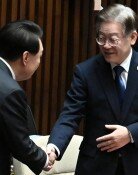Seoul, Washington agree to relocate CFC to Pyeongtaek
Seoul, Washington agree to relocate CFC to Pyeongtaek
Posted June. 04, 2019 07:36,
Updated June. 04, 2019 07:36
South Korea and the U.S. agreed to relocate ROK-U.S. Combined Forces Command (CFC) to Camp Humphreys in Pyeongtaek during defense ministers’ talks held Monday. The future joint command, which will act as a joint command in case of emergency after the transition of wartime operational control (OPCON), will also be moved to Pyeongtaek. Initially, the two countries had signed a memorandum of understanding (MOU) on the establishment of the headquarters of the future joint command inside the Ministry of Defense building in Yongsan, Seoul and had been discussing ways to do so. But the decision has been overturned in a year.
Upon his appointment in November last year, Gen. Robert Abrams, the commander of the CFC, has argued that the CFC should be relocated to Pyeongtaek citing reasons such as the ineffectiveness resulting from the distance between Yongsan and Pyeongtaek. It has been known that U.S. President Donald Trump has approved his proposal. “We agreed with the U.S. that the relocation will improve the efficiency of the CFC’s operations and strengthen our defense posture,” said the South Korean Defense Ministry. But a sudden relocation of the CFC and the future joint command coupled with a fundamental change in our defense system ㅡ transition of OPCON ㅡ causes concerns about our joint defense posture in case of emergency.
Some say the proposal by the U.S. to relocate the CFC and the future joint command, which will exercise OPCON, inside a U.S. military base, is an expression of its discomfort with the command system after the transition of the OPCON since the U.S. has never been under the command of other countries. Defense ministers of the two countries Monday agreed to name a separate commander for the joint future command, another decision that can result in ineffective command system in case of emergency.
The relocation of the heart of the ROK-U.S. military alliance is a symbolic move. But having the Ministry of Defense and the Joint Chiefs of Staff in Seoul, and the CFC in Pyeongtaek might weaken military capabilities of the two countries. In case of emergency on the Korean Peninsula, which would not allow a moment’s delay, physical distance might undermine effective command and communication. The two countries should be prepared to deal with all possibilities so that the relocation will not negatively affect the joint defense posture in any way.
Nuclear negotiations between the U.S. and North Korea are in deadlock and the North fired short-range missiles last month. North Korean nuclear and missiles weapons are existing threats. The Trump administration wants South Korea to pay more for the U.S. military forces stationed in the country under its “America First”policy. Under these circumstances, Seoul and Washington should cooperate more closely so that the relocation will not be interpreted as weakening ROK-U.S. alliance or joint command posture in the OPCON transition process.
Headline News
- Med professors announce intention to leave hospitals starting Thursday
- Bridge honoring Sgt. Moon Jae-sik unveiled in Pennsylvania
- Chief of Staff Chung tells presidential secretaries to stay away from politics
- US FTC bans noncompete agreements
- N. Korea launches cyberattacks on S. Korea's defense companies







